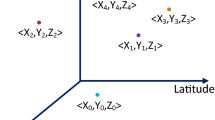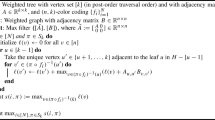Abstract
Most conventional spatial smoothers smooth with respect to the Euclidean distance between observations, even though this distance may not be a meaningful measure of spatial proximity, especially when boundary features are present. When domains have complicated boundaries leakage (the inappropriate linking of parts of the domain which are separated by physical barriers) can occur. To overcome this problem, we develop a method of smoothing with respect to generalized distances, such as within domain distances. We obtain the generalized distances between our points and then use multidimensional scaling to find a configuration of our observations in a Euclidean space of 2 or more dimensions, such that the Euclidian distances between points in that space closely approximate the generalized distances between the points. Smoothing is performed over this new point configuration, using a conventional smoother. To mitigate the problems associated with smoothing in high dimensions we use a generalization of thin plate spline smoothers proposed by Duchon (Constructive theory of functions of several variables, pp 85–100, 1977). This general method for smoothing with respect to generalized distances improves on the performance of previous within-domain distance spatial smoothers, and often provides a more natural model than the soap film approach of Wood et al. (J R Stat Soc Ser B Stat Methodol 70(5):931–955, 2008). The smoothers are of the linear basis with quadratic penalty type easily incorporated into a range of statistical models.







Similar content being viewed by others
References
Augustin N, Musio M, von Wilpert K, Kublin E, Wood SN, Schumacher M (2009) Modeling spatiotemporal forest health monitoring data. J Am Stat Assoc 104(487):899–911
Bernstein M, De Silva V, Langford J, Tenenbaum J (2000) Graph approximations to geodesics on embedded manifolds. Technical report, Department of Psychology, Stanford University. ftp://ftp-sop.inria.fr/prisme/boissonnat/ImageManifolds/isomap.pdf
Chatfield C, Collins AJ (1980) Introduction to multivariate analysis. Science paperbacks, Chapman and Hall
Curriero F (2005) On the use of non-euclidean isotropy in geostatistics. Technical report 94, Johns Hopkins University, Department of Biostatistics. http://www.bepress.com/cgi/viewcontent.cgi?article=1094&context=jhubiostat
Driscoll TA, Trefethen L (2002) Schwartz-Christoffel transform. Cambridge University Press, Cambridge
Duchon J (1977) Splines minimizing rotation-invariant semi-norms in Sobolev spaces. Constructive theory of functions of several variables, pp 85–100
Floyd RW (1962) Algorithm 97: shortest path. Commun. ACM 5(6):345–345
Gower J (1968) Adding a point to vector diagrams in multivariate analysis. Biometrika 55(3):582
Hastie TJ, Tibshirani RJ (1990) Generalized additive models. Monographs on statistics and applied probability. Taylor & Francis, New York
Higham NJ (1987) Computing real square roots of a real matrix. Linear Algebra Appl 88–89:405–430. doi:10.1016/0024-3795(87)90118-2
Jensen OP, Christman MC, Miller TJ (2006) Landscape-based geostatistics: a case study of the distribution of blue crab in Chesapeake Bay. Environmetrics 17(6):605–621. doi:10.1002/env.767
Løland A, Høst G (2003) Spatial covariance modelling in a complex coastal domain by multidimensional scaling. Environmetrics 14(3):307–321. doi:10.1002/env.588
Miller DL (2012) On smooth models for complex domains and distances. PhD thesis, University of Bath
Miller DL, Burt ML, Rexstad EA (2013) Spatial models for distance sampling data: recent developments and future directions. Methods in Ecology and Evolution
Oh MS, Raftery AE (2001) Bayesian multidimensional scaling and. J Am Stat Assoc 96(455):1031
Ramsay T (2002) Spline smoothing over difficult regions. J R Stat Soc Ser B Stat Methodol 64(2):307–319
Rue H, Held L (2005) Gaussian Markov random fields: theory and applications. Monographs on statistics and applied probability. Taylor & Francis, New York
Ruppert D, Wand M, Carroll RJ (2003) Semiparametric regression. Cambridge series on statistical and probabilistic mathematics. Cambridge University Press, Cambridge
Sampson PD, Guttorp P (1992) Nonparametric estimation of nonstationary spatial covariance structure. J Am Stat Assoc 87(417):108–119
Scott-Hayward LAS, MacKenzie ML, Donovan CR, Walker CG, Ashe E (2013) Complex region spatial smoother (CReSS). J Comput Graph. Stat. doi: 10.1080/10618600.2012.762920
Vretblad A (2003) Fourier analysis and its applications. Graduate texts in mathematics. Springer, Berlin
Wang H, Ranalli M (2007) Low-rank smoothing splines on complicated domains. Biometrics 63(1):209–217
Williams R, Hedley SL, Branch TA, Bravington MV, Zerbini AN, Findlay KP (2011) Chilean blue whales as a case study to illustrate methods to estimate abundance and evaluate conservation status of rare species. Conserv Biol 25(3):526–535. doi:10.1111/j.1523-1739.2011.01656.x
Wood SN (2003) Thin plate regression splines. J R Stat Soc Ser B Stat Methodol 65(1):95–114
Wood SN (2006) Generalized additive models: an introduction with R. Chapman & Hall/CRC, London
Wood SN (2011) Fast stable restricted maximum likelihood and marginal likelihood estimation of semiparametric generalized linear models. J R Stat Soc Ser B Stat Methodol 73(1):3–36
Wood SN, Bravington MV, Hedley SL (2008) Soap film smoothing. J R Stat Soc Ser B Stat Methodol 70(5):931–955
Acknowledgments
We are especially grateful to Jean Duchon for generous help in understanding Duchon (1977). David wishes to thank EPSRC for financial support during his PhD at the University of Bath.
Author information
Authors and Affiliations
Corresponding author
Additional information
Handling Editor: Ashis SenGupta.
Electronic supplementary material
Below is the link to the electronic supplementary material.
Rights and permissions
About this article
Cite this article
Miller, D.L., Wood, S.N. Finite area smoothing with generalized distance splines. Environ Ecol Stat 21, 715–731 (2014). https://doi.org/10.1007/s10651-014-0277-4
Received:
Revised:
Published:
Issue Date:
DOI: https://doi.org/10.1007/s10651-014-0277-4




